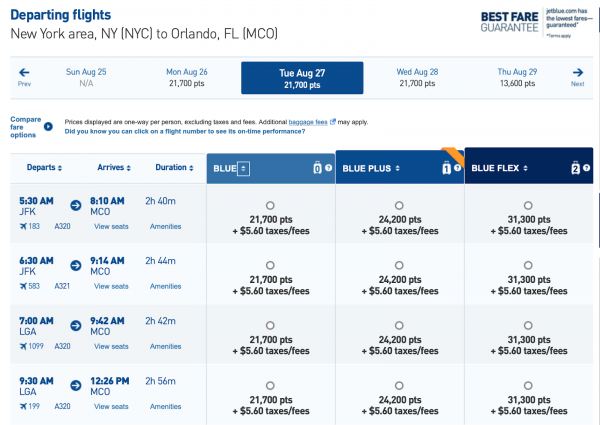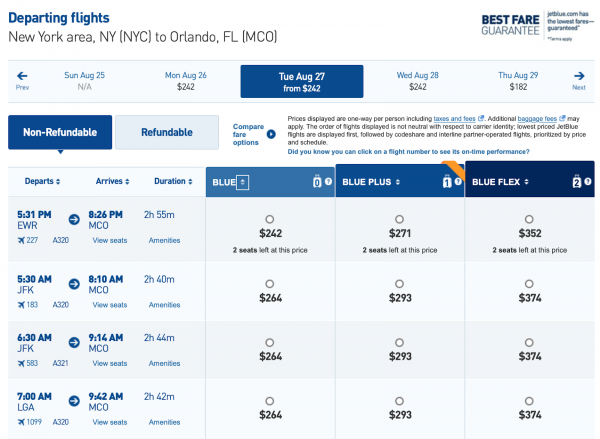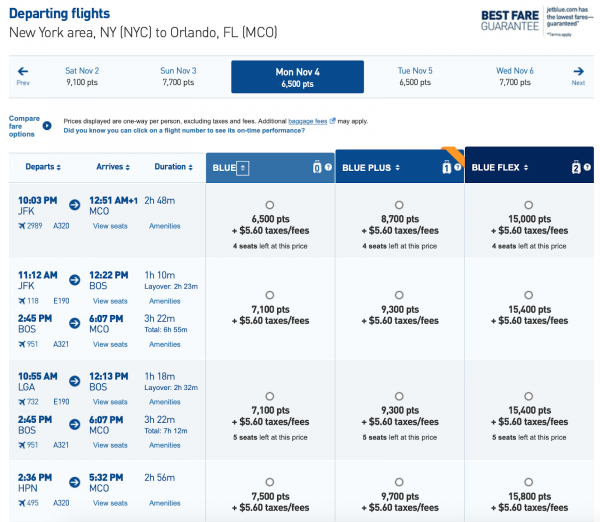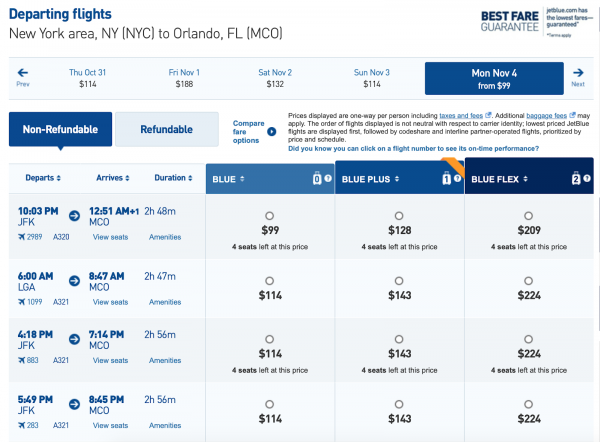Your Guide to Booking Award Flights on JetBlue

Many or all of the products on this page are from partners who compensate us when you click to or take an action on their website, but this does not influence our evaluations or ratings. Our opinions are our own.
As many airlines have done recently, JetBlue has long ditched the concept of a set award chart in favor of a dynamic one. With JetBlue, award pricing is tied to the cash cost of a ticket — the cheaper a flight is in cash, the fewer points you’ll need to redeem. That can end up being a good or bad thing, depending on how you typically travel.
» Learn more: JetBlue TrueBlue rewards program: The complete guide
How JetBlue TrueBlue points work
Let’s start with the good news: You can redeem TrueBlue points on any JetBlue flight with no blackout dates. You can also use them for nearly any seat, from Blue Basic (JetBlue’s version of economy) to Mint (JetBlue’s version of first class). That’s great if you want flexibility and convenience out of a frequent flyer program. You cannot redeem TrueBlue points for a Blue Basic fare, which is JetBlue’s version of basic economy.
On the downside, because redemption rates are based on airfare prices, the points you’ll need can fluctuate significantly depending on the route and during peak travel times. Take a flight from New York to Orlando, for example. The cash price for a flight might be $326 or 21,700 points, making points worth about 1.5 cents. But the exact point value fluctuates when comparing several different travel dates.




Think of it this way: The popularity of a flight from New York to Orlando varies throughout the year. A flight would likely be more popular in the summer versus the fall, so the price would likewise be higher. And since redemption rates are directly tied to the cash price of current fares, more expensive flights will require more points. That means that flying a popular route on off-peak dates can be incredibly useful for saving points.
JetBlue’s fare types
JetBlue has five different fare types: Blue Basic, Blue, Blue Plus, Blue Extra and Mint. All fare classes include JetBlue’s beloved benefits like brand-name snacks, free high-speed Wi-Fi and DirecTV.
Blue Basic
Blue Basic is JetBlue’s version of basic economy. By booking in the lowest fare class, you’ll forgo somewhat basic benefits like the ability to select your seats prior to check-in (unless you pay an additional fee). You’ll board with one of the last boarding groups, and you won’t be able to use your points to pay for this type of fare. Plus, Blue Basic is the only one of JetBlue’s fare classes that charges a fee to cancel your flight.
Blue
Blue seats come with some benefits that you won’t find on Blue Basic, like the ability to choose a seat. But these fares lack useful perks like free checked bags.
Blue Plus
Blue Plus is mostly the same as the Blue fare class, though it includes a free checked bag.
Blue Extra
Blue Extra includes benefits such as early boarding and advance seat selections. Every passenger gets a carry-on bag and a personal item. Oddly, although considered a “higher” fare than Blue Plus, Blue Extra does not come with a free checked bag.
Mint
Mint is JetBlue’s first class, offering luxurious benefits like lie-flat seats that also have a massage function. The food is fancier too, with options including seasonal small plates, espresso, treats like ice cream and an alcoholic welcome refreshment.
Things to know about JetBlue TrueBlue
If you’re paying for your flight in cash instead of points, know that by booking directly on JetBlue’s website, you’ll earn more points: at least 6 points per $1. And if you want to transfer your points to another TrueBlue member, you can do that thanks to the Points Pooling feature.
If you don’t have enough points to book your flight, you can also opt to pay for airfare with a combination of cash and points (though Blue Basic fares are not eligible to be booked on points or with a combination of cash and points).
Want to book an award flight with one of JetBlue’s partner airlines? You can also redeem points on Hawaiian Airlines flights.
Earn more points with TrueBlue credit cards
If you want more points fast, JetBlue offers three co-branded credit cards so travelers can rack up points quicker.
JetBlue Card
The JetBlue Card usually carries a lower sign-up bonus, though you will earn 3x points on JetBlue flight purchases, 2x points on restaurants and grocery stores and 1x points on everything else.
Cardholders also get a 50% discount on inflight purchases. In our opinion, the lack of benefits that come with this card make it fairly unattractive.
JetBlue Plus Card
The JetBlue Plus Card offers many of the same benefits. Here's the sign-up bonus: Earn 70,000 bonus points after spending $1,000 on purchases and paying the annual fee in full, both within the first 90 days, with the JetBlue Plus Card.
For a $99 annual fee, you’ll receive a higher 6x points per $1 spent on JetBlue purchases. This card also offers 5,000 bonus points after every cardmember anniversary and a free checked bag for you and three travel companions. You’ll even qualify for Mosaic status if you spend $50,000 or more on your card in a calendar year.
JetBlue Business Card
For business owners, the JetBlue Business Card is one more step up, though a small one. The earning structure, sign-up bonus and annual fee are similar to the JetBlue Plus Card. But you have the chance to earn an additional 10,000 points when a purchase is made on an employee card during the first 90 days.
You can also transfer Chase Ultimate Rewards® points or Citi ThankYou points to your TrueBlue account at a 1:1 ratio.
» Learn More: Find the best airline credit card for you
The bottom line
While JetBlue has no award chart to speak of, their award structure based on cash fares can be a blessing or a curse. Fly during off-peak dates or on less popular routes and you can find amazing deals. If you have to stick to a set schedule and destination, however, you may end up cashing in more points than you’d like. But if you are patient and flexible, you may be rewarded with award travel that feels like just that.
How to maximize your rewards
You want a travel credit card that prioritizes what’s important to you. Here are some of the best travel credit cards of 2025:
Flexibility, point transfers and a large bonus: Chase Sapphire Preferred® Card
No annual fee: Wells Fargo Autograph® Card
Flat-rate travel rewards: Capital One Venture Rewards Credit Card
Bonus travel rewards and high-end perks: Chase Sapphire Reserve®
Luxury perks: The Platinum Card® from American Express
Business travelers: Ink Business Preferred® Credit Card
Chase Sapphire Preferred® Card
Travel
Dining
🔥 Huge highest-ever bonus on NerdWallet's 2025 Best All-Purpose Travel Rewards Card is back. Don't miss your rare chance to: Earn 100,000 points when you spend $5,000 on purchases in the first three months. That's worth at least $1,250 toward travel booked through Chase.



